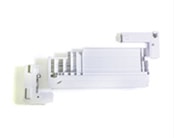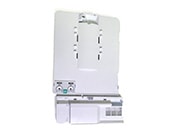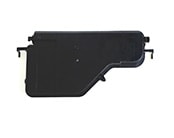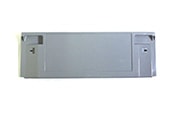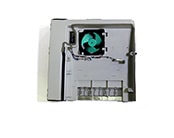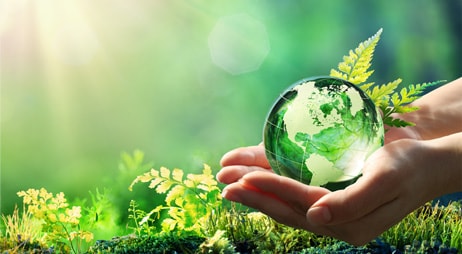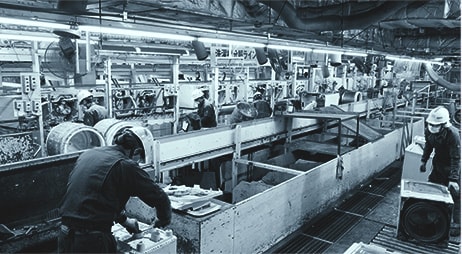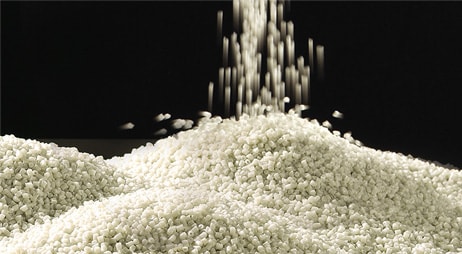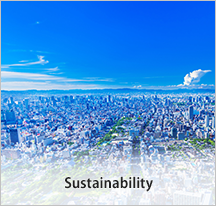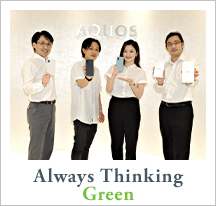
Quality Control Efforts Include Removing Foreign Matter and Formulating Additives
Tatsuya Arai, Researcher
R&D Division, Smart Appliances & Solutions Business Unit
(Department and job title as of November 22, 2019)
Sorting Materials by First Removing Foreign Matter with Water Sink-float Separation and Pneumatic Separation
Kansai Recycling Systems does its best to remove foreign matter from plastic parts and sort the plastic into different types, but when this is difficult the plant has to crush the product and then do separation and processing after. This separation and processing of materials makes use of the difference in physical properties between the materials you want to keep and those you want to throw away. For example, to recover the polypropylene (PP) from the crushed matter of compound parts, we use water sink-float (specific gravity) separation, in which the polypropylene floats on water while the other plastics, rubber, and metal that are heavier than water sink and can be removed. We also use pneumatic (blown air) separation, in which lightweight foreign matter such as sponge and labels gets blown away by a fan and only the high-purity polypropylene remains. The conditions required to carry out water separation and wind separation differ depending on the combination of materials to be separated. I’ll never forget the long hours of experimenting we did to find the ideal conditions for these separation methods.
High-purity PP Separation and Recovery Technology

Blending Additives That Restore Plastic’s Performance and Give Added Value
Because appliances have been used in varying conditions, things like the properties and durability of their plastic have deteriorated by the time they are collected for recycling. In order to use this plastic as recycled material, we accurately determine what is damaged and how performance has deteriorated, and then use the proper additives—the same way we give sick people medicine—to make the material as good as new.
We are also developing new recycled materials with added value by, for example, blending two plastics with different characteristics, and giving the material properties such as stiffness, flame retardancy, and microbe resistance.
To arrive at the right kind and amount of additives, we carry out exhaustive tests. This is an arduous task, but we always look forward to developing new things and that makes our job worthwhile.
Restoring Recycled Materials and Giving Them Added Value

Removing Tiny Foreign Matter with Screen Mesh
After additive blending, materials are melted and extruded, and then finally made into pellets (see here for a detailed flow). In the extrusion process, the melted plastic is put through a screen mesh (wire mesh) in order to remove the tiny particles that could not be removed by water sink-float (specific gravity) separation and pneumatic (blown air) separation. If the mesh holes are too large, foreign matter can pass through and if they are too small, the mesh gets clogged and this hurts productivity. Therefore, the optimal mesh size must be found.

Screen mesh

Foreign matter stuck in the screen mesh

Quality Control Is Crucial to Recycling—
It Starts with Establishing Standards
Hiromichi Ueda, Researcher
R&D Division, Smart Appliances & Solutions Business Unit
(Department and job title as of November 22, 2019)
Achieving Desired Durability through Accelerated Aging Testing
I think that quality control is the most important aspect of developing recycled materials. The degree of deterioration of various recovered plastics is never the same because the products the plastics came from were used in different environments and for different lengths of time, and were collected by manufacturers at different points in time. It is therefore important to achieve a fixed standard of quality for recycled materials that will go into new appliances.
One way to determine whether a material is strong enough to withstand long periods of use is to place a test piece of recycled material for several months in a high-temperature test tank that simulates a situation of long-term product usage. This test to determine the state of deterioration is called accelerated aging testing. But you must decide on standards to guide your test decision; for example, the conditions under which you should accelerate aging, and the standard for deciding whether materials are of good enough quality to be used in new appliances. Because the level of deterioration in the recovered plastic varies widely, it was difficult for us to establish standards that everyone could agree on.
Examples of Recycled Plastic Use
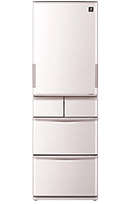
Refrigerator
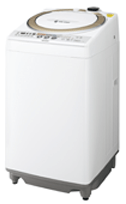
Washing machine
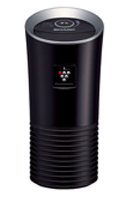
Car Plasmacluster Ion generator
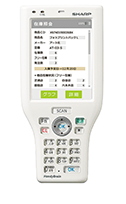
Handheld device (Handy Terminal)

Where recycled material is used in a new product
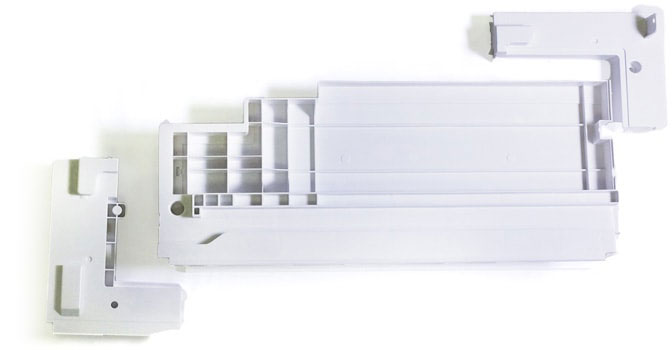
| Recycled plastic | PP |
|---|---|
| Part | Divider |
| Source | Refrigerator vegetable case |

Where recycled material is used in a new product
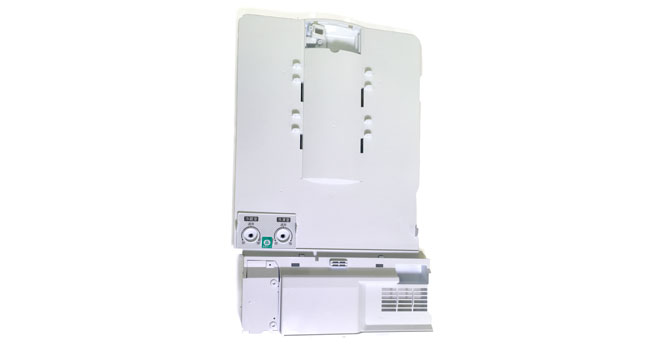
| Recycled plastic | PP |
|---|---|
| Part | Duct cover |
| Source | Refrigerator vegetable case |

Where recycled material is used in a new product
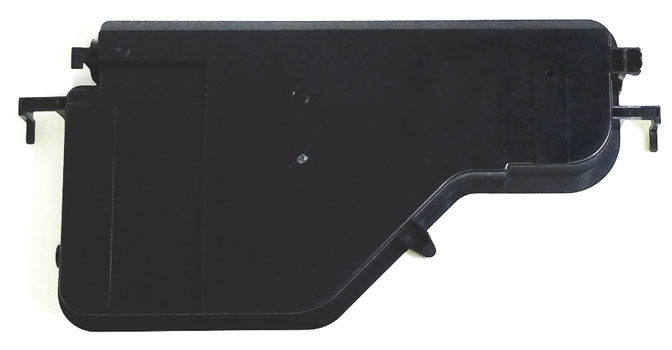
| Recycled plastic | Flame-retardant PS |
|---|---|
| Part | Electrical box |
| Source | Flat-panel TV back cabinet |

Where recycled material is used in a new product
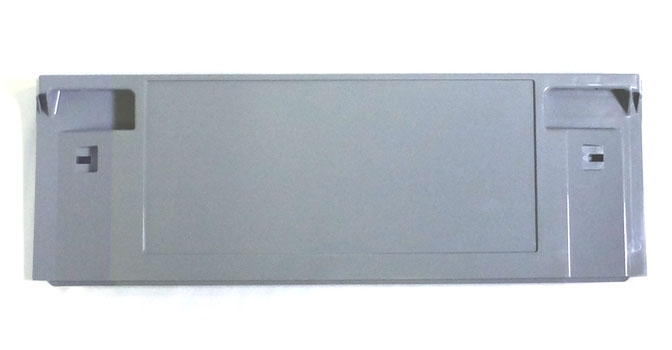
| Recycled plastic | PP |
|---|---|
| Part | Handgrips |
| Source | Washing machine top plate, outer cabinet, other |

Where recycled material is used in a new product
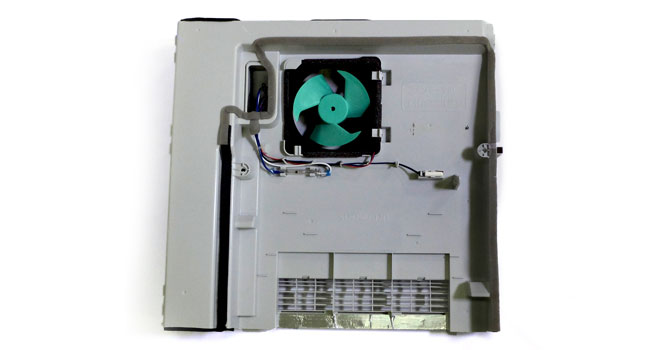
| Recycled plastic | PP |
|---|---|
| Part | Evaporator cover |
| Source | Washing machine spin tub, balancer, other |

| Recycled plastic | PP |
|---|---|
| Part | Washing tub |
| Source | Washing machine tub |
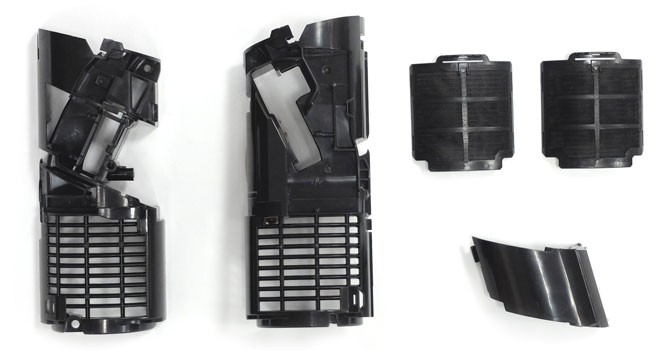
| Recycled plastic | Flame-retardant PC + ABS |
|---|---|
| Part | Internal parts |
| Source | Flat-panel TV back cabinet |
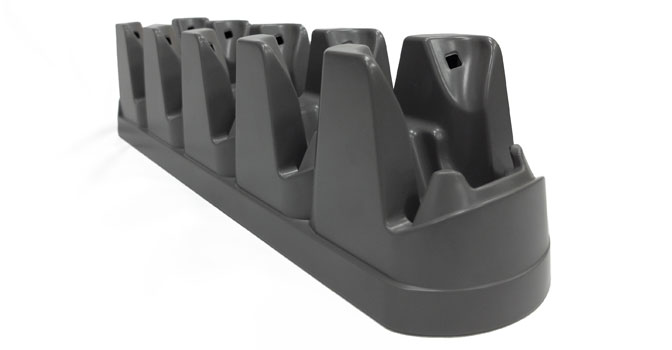
| Recycled plastic | Flame-retardant PC + ABS |
|---|---|
| Part | Charger |
| Source | Flat-panel TV back cabinet |
Developing Recycled-plastic Material with Added Value
In response to the increasing seriousness of pollution from used plastic, the world has embarked on numerous initiatives such as the UN Sustainable Development Goals (SDGs)*1. Countries are making laws regarding the recycling of used plastic and strengthening restrictions on importing plastic waste. In Japan, the Plastic Resource Recycling Strategy*2 was formulated and systems are gradually being put in place for recycling used plastics. The social situation surrounding used plastic has drastically changed as it becomes increasingly important to properly dispose of and recycle the material.
Against this background, Sharp is working on new initiatives toward creating more uses for recycled plastics; not only through horizontal recycling, in which recovered plastics are made as good as new material and used in the same parts as originally used, but also through upgrade recycling, in which the recycled plastic is given added value with flame retardancy, weather resistance, or high stiffness.
- *1: Adopted by the United Nations in 2015, the SDGs are a set of 17 goals for the sustainable development of society to be achieved by 2030.
- *2: Formulated on May 31, 2019 by the Japanese government, it aims to address a wide range of issues, such as restrictions on resources and waste, ocean plastic, global warming, and restrictions in Asian countries on the importing of waste. The strategy’s basic principle is “3Rs + Renewable”.
Used Plastic Recycling Method

Hopes for Closed-loop Plastic Material Recycling Technology
Our golden rule is to repeatedly recover plastic from used products and use it over and over in new products. We believe it is a manufacturer’s responsibility to continue and expand such recycling efforts.
We have up to now developed closed-loop plastic material recycling technology for the main types of plastic used in appliances, using the plastic we recover from used appliances in new Sharp products. However, there is still a lot of different types of plastic in used products that we haven’t been able to recycle due to the difficulty of doing so and other factors.
In future, we plan to focus on new developments; for example, technologies for efficient use of currently difficult-to-recycle materials, upgrade recycling technologies that expand the uses of recycled materials (for example, technologies that give material greater performance and allow its color to be controlled), and products whose plastic parts are easy to disassemble and recycle.
We hope that recycling technologies that Sharp currently uses only in-house can in future be applied in other industries and around the world, thus allowing our company to do its part in solving worldwide problems like plastic waste and global warming.


